Food Safety Management Report: UK Restaurant Case Study
VerifiedAdded on 2021/01/02
|13
|3499
|166
Report
AI Summary
This report provides a comprehensive overview of food safety management, addressing critical aspects relevant to the hospitality industry, with a specific focus on a UK restaurant case study. The report begins with an introduction to food safety, emphasizing its global significance and the importance of preventing foodborne illnesses. It then delves into the categorization of food spoilage agents, detailing various types such as molds, insects, bacteria, and yeasts. Subsequently, it explores various food preservation methods, including refrigeration, canning, pasteurization, and filtration, evaluating their effectiveness in maintaining food safety and extending shelf life. The report further examines key steps in temperature control systems, safe storage methods, and the importance of personal hygiene, cleaning, and disinfection in preventing food contamination. It also addresses the challenges of pest control and the necessity of hygienic design and construction of food premises. The importance of training for quality assurance mechanisms is highlighted. Furthermore, the report discusses food hazard risk assessment, food safety control systems, and compliance with food safety legislation, culminating in a conclusion that summarizes the key findings and recommendations for ensuring food safety in the restaurant setting. The report is supported by relevant references. The content is designed to help students understand the principles and practices of food safety management within the context of a hospitality setting.
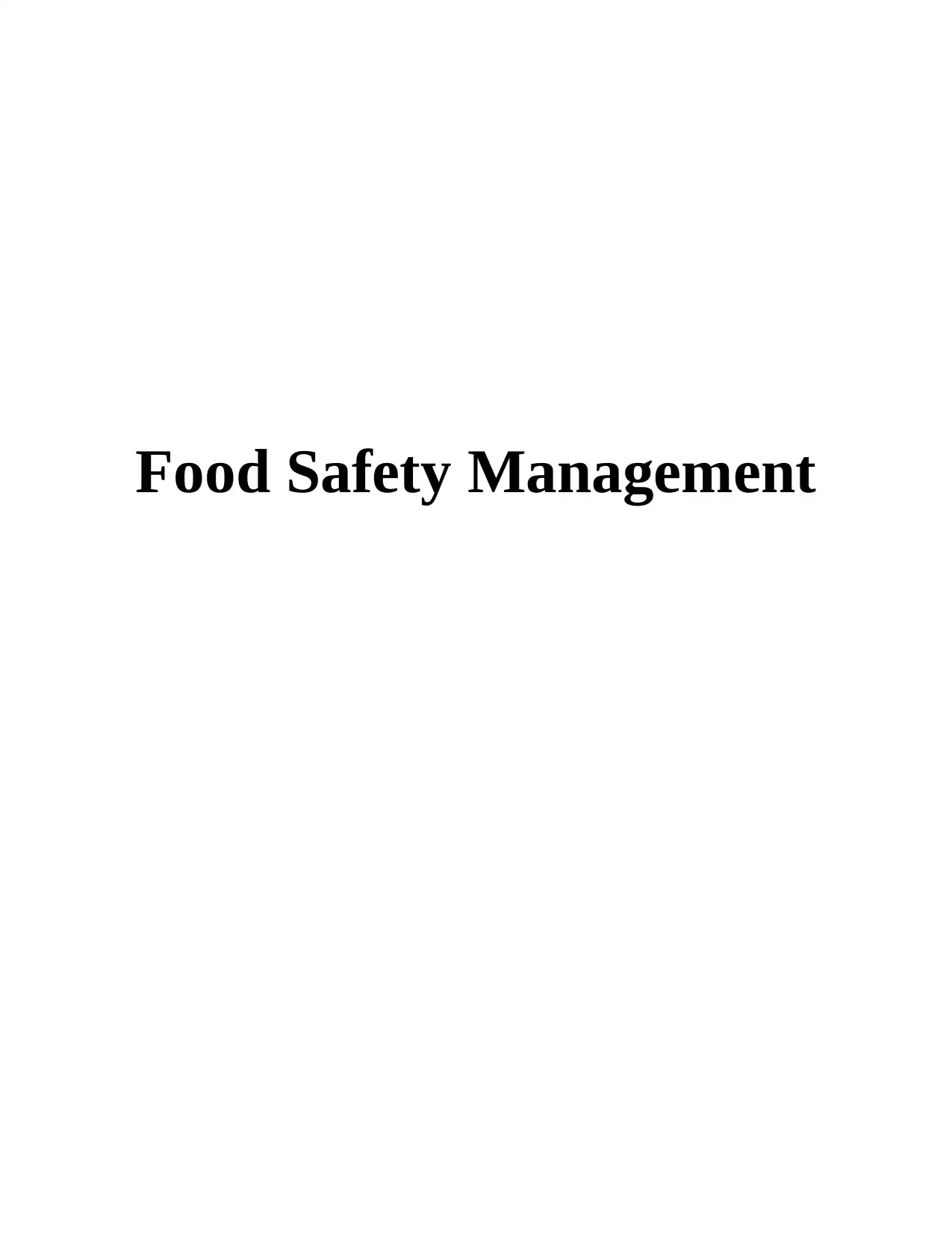
Food Safety Management
Paraphrase This Document
Need a fresh take? Get an instant paraphrase of this document with our AI Paraphraser
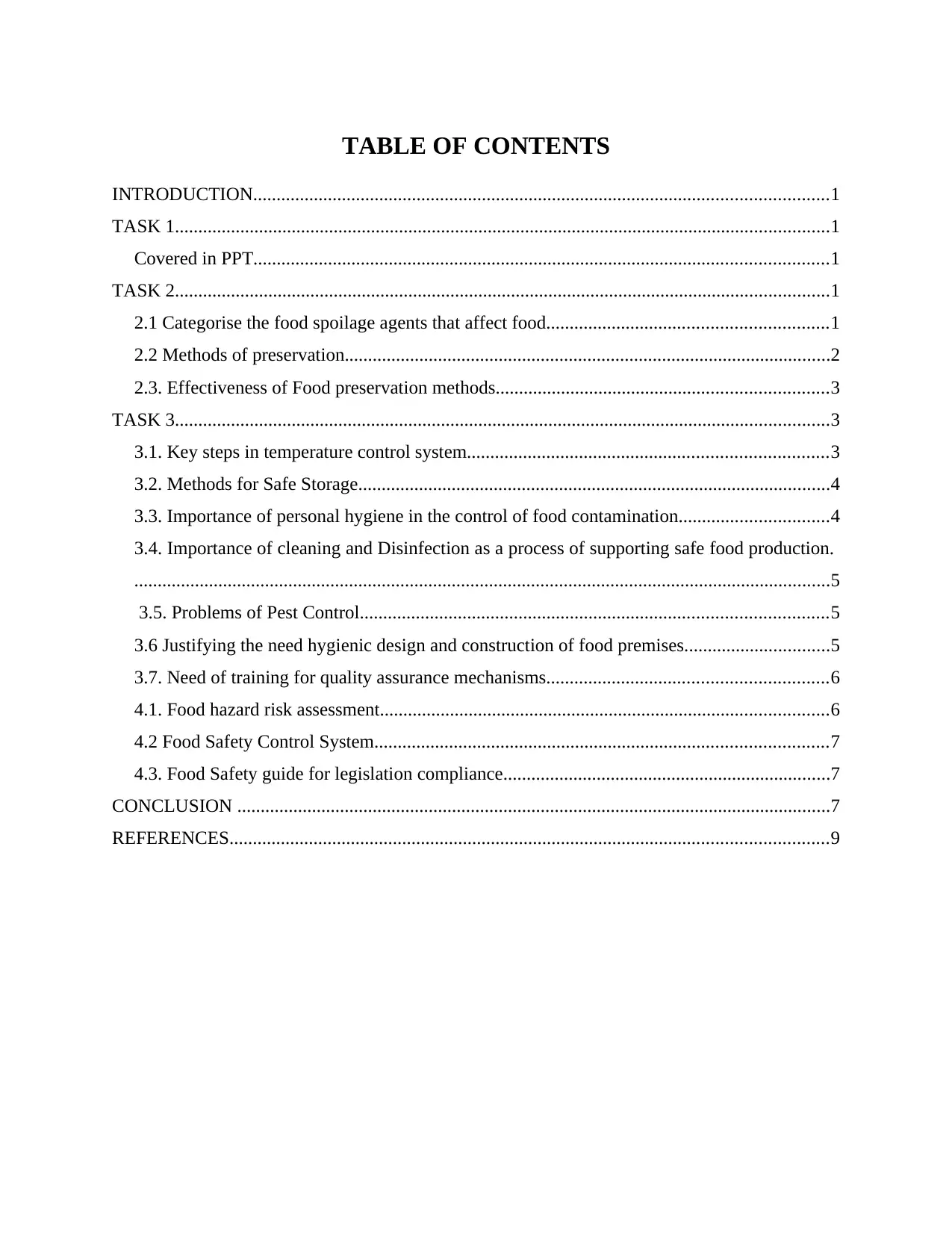
TABLE OF CONTENTS
INTRODUCTION...........................................................................................................................1
TASK 1............................................................................................................................................1
Covered in PPT...........................................................................................................................1
TASK 2............................................................................................................................................1
2.1 Categorise the food spoilage agents that affect food............................................................1
2.2 Methods of preservation........................................................................................................2
2.3. Effectiveness of Food preservation methods.......................................................................3
TASK 3............................................................................................................................................3
3.1. Key steps in temperature control system.............................................................................3
3.2. Methods for Safe Storage.....................................................................................................4
3.3. Importance of personal hygiene in the control of food contamination................................4
3.4. Importance of cleaning and Disinfection as a process of supporting safe food production.
.....................................................................................................................................................5
3.5. Problems of Pest Control....................................................................................................5
3.6 Justifying the need hygienic design and construction of food premises...............................5
3.7. Need of training for quality assurance mechanisms............................................................6
4.1. Food hazard risk assessment................................................................................................6
4.2 Food Safety Control System.................................................................................................7
4.3. Food Safety guide for legislation compliance......................................................................7
CONCLUSION ...............................................................................................................................7
REFERENCES................................................................................................................................9
INTRODUCTION...........................................................................................................................1
TASK 1............................................................................................................................................1
Covered in PPT...........................................................................................................................1
TASK 2............................................................................................................................................1
2.1 Categorise the food spoilage agents that affect food............................................................1
2.2 Methods of preservation........................................................................................................2
2.3. Effectiveness of Food preservation methods.......................................................................3
TASK 3............................................................................................................................................3
3.1. Key steps in temperature control system.............................................................................3
3.2. Methods for Safe Storage.....................................................................................................4
3.3. Importance of personal hygiene in the control of food contamination................................4
3.4. Importance of cleaning and Disinfection as a process of supporting safe food production.
.....................................................................................................................................................5
3.5. Problems of Pest Control....................................................................................................5
3.6 Justifying the need hygienic design and construction of food premises...............................5
3.7. Need of training for quality assurance mechanisms............................................................6
4.1. Food hazard risk assessment................................................................................................6
4.2 Food Safety Control System.................................................................................................7
4.3. Food Safety guide for legislation compliance......................................................................7
CONCLUSION ...............................................................................................................................7
REFERENCES................................................................................................................................9
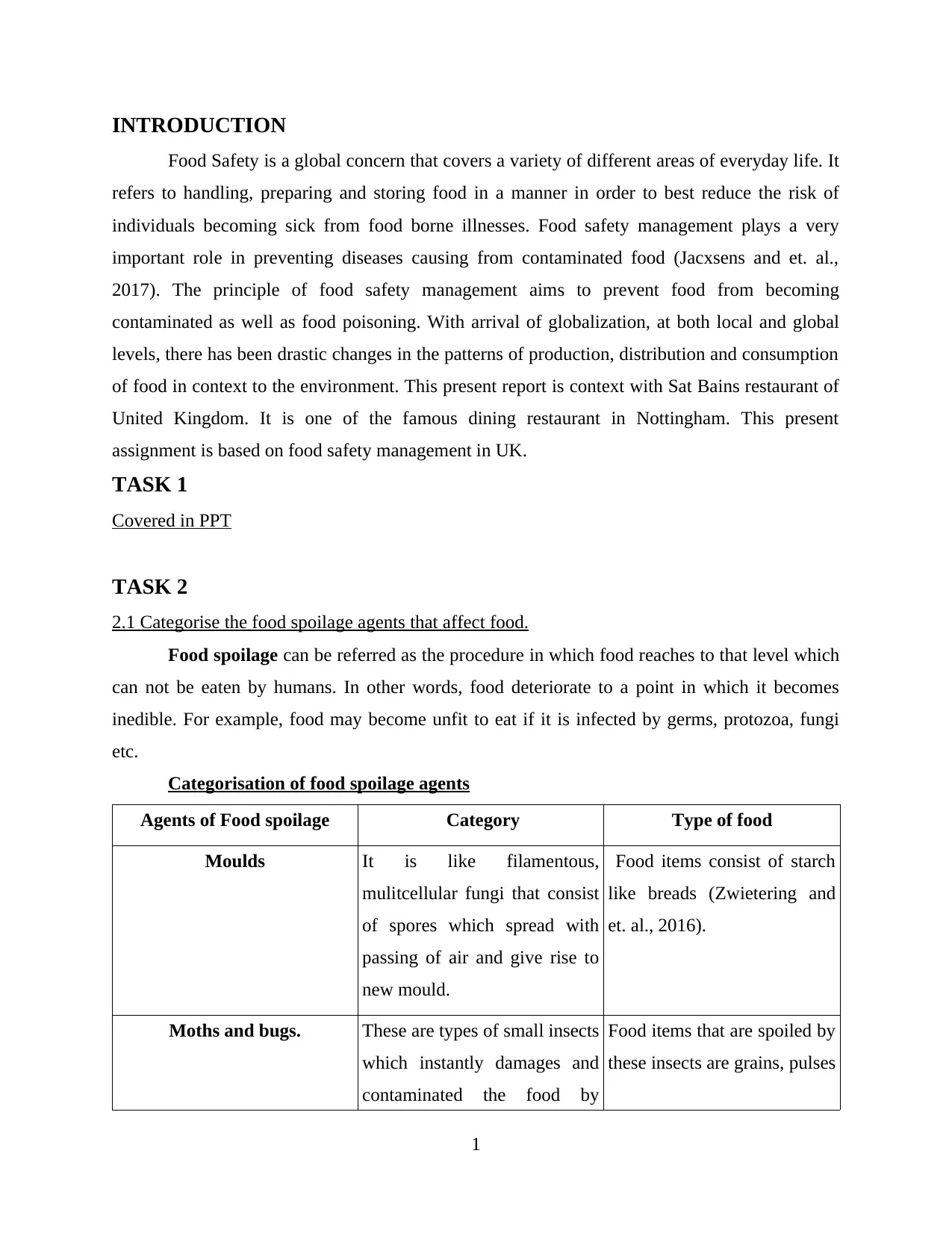
INTRODUCTION
Food Safety is a global concern that covers a variety of different areas of everyday life. It
refers to handling, preparing and storing food in a manner in order to best reduce the risk of
individuals becoming sick from food borne illnesses. Food safety management plays a very
important role in preventing diseases causing from contaminated food (Jacxsens and et. al.,
2017). The principle of food safety management aims to prevent food from becoming
contaminated as well as food poisoning. With arrival of globalization, at both local and global
levels, there has been drastic changes in the patterns of production, distribution and consumption
of food in context to the environment. This present report is context with Sat Bains restaurant of
United Kingdom. It is one of the famous dining restaurant in Nottingham. This present
assignment is based on food safety management in UK.
TASK 1
Covered in PPT
TASK 2
2.1 Categorise the food spoilage agents that affect food.
Food spoilage can be referred as the procedure in which food reaches to that level which
can not be eaten by humans. In other words, food deteriorate to a point in which it becomes
inedible. For example, food may become unfit to eat if it is infected by germs, protozoa, fungi
etc.
Categorisation of food spoilage agents
Agents of Food spoilage Category Type of food
Moulds It is like filamentous,
mulitcellular fungi that consist
of spores which spread with
passing of air and give rise to
new mould.
Food items consist of starch
like breads (Zwietering and
et. al., 2016).
Moths and bugs. These are types of small insects
which instantly damages and
contaminated the food by
Food items that are spoiled by
these insects are grains, pulses
1
Food Safety is a global concern that covers a variety of different areas of everyday life. It
refers to handling, preparing and storing food in a manner in order to best reduce the risk of
individuals becoming sick from food borne illnesses. Food safety management plays a very
important role in preventing diseases causing from contaminated food (Jacxsens and et. al.,
2017). The principle of food safety management aims to prevent food from becoming
contaminated as well as food poisoning. With arrival of globalization, at both local and global
levels, there has been drastic changes in the patterns of production, distribution and consumption
of food in context to the environment. This present report is context with Sat Bains restaurant of
United Kingdom. It is one of the famous dining restaurant in Nottingham. This present
assignment is based on food safety management in UK.
TASK 1
Covered in PPT
TASK 2
2.1 Categorise the food spoilage agents that affect food.
Food spoilage can be referred as the procedure in which food reaches to that level which
can not be eaten by humans. In other words, food deteriorate to a point in which it becomes
inedible. For example, food may become unfit to eat if it is infected by germs, protozoa, fungi
etc.
Categorisation of food spoilage agents
Agents of Food spoilage Category Type of food
Moulds It is like filamentous,
mulitcellular fungi that consist
of spores which spread with
passing of air and give rise to
new mould.
Food items consist of starch
like breads (Zwietering and
et. al., 2016).
Moths and bugs. These are types of small insects
which instantly damages and
contaminated the food by
Food items that are spoiled by
these insects are grains, pulses
1
⊘ This is a preview!⊘
Do you want full access?
Subscribe today to unlock all pages.

Trusted by 1+ million students worldwide

eating it. etc.
Bacteria There are some living
organisms that spoils the food.
bacilli
Cocci
spirilla,
Basically, food that stored in
cold areas are affected for
example food kept in
refrigerator or freezers are
spoiled by these bacteria.
Yeasts These are unicellular fungi that
consist chlorophyll II, needs
water as well as energy source
like sugar to outspread
(Koutsoumanis and Gougouli,
2015).
Honey, Molasses, fruit juices,
syrups, jellies etc. are the food
items which are spoiled by
this kind of fungi.
2.2 Methods of preservation.
There are various methods of preservation which the staff member of Sat Bians
Restaurant could use are as follows-
Refrigeration
Canning
Pasteurization
Filtration
Refrigeration: This is the best way to store to preserve the food from spoilage. The
temperature of freezers (2 degree C to 16 degree C) slows growth of microbial but cannot
remove completely. Preserving food for shorter period this method is good.
Canning- This method is one of the best way to store food items for long period. In this
method, food is cooked under pressure in order to attain a temperature high enough in order to
demolish endospores. After coming this process, next process of using cold water is used.
Pasteurization- This is another method to kill the micro-organisms by heating food to a
temperature. It also minimises the level of decaying organism with fewer effects in the value and
texture of food (Tzamalis, Panagiotakos and Drosinos, 2016).
2
Bacteria There are some living
organisms that spoils the food.
bacilli
Cocci
spirilla,
Basically, food that stored in
cold areas are affected for
example food kept in
refrigerator or freezers are
spoiled by these bacteria.
Yeasts These are unicellular fungi that
consist chlorophyll II, needs
water as well as energy source
like sugar to outspread
(Koutsoumanis and Gougouli,
2015).
Honey, Molasses, fruit juices,
syrups, jellies etc. are the food
items which are spoiled by
this kind of fungi.
2.2 Methods of preservation.
There are various methods of preservation which the staff member of Sat Bians
Restaurant could use are as follows-
Refrigeration
Canning
Pasteurization
Filtration
Refrigeration: This is the best way to store to preserve the food from spoilage. The
temperature of freezers (2 degree C to 16 degree C) slows growth of microbial but cannot
remove completely. Preserving food for shorter period this method is good.
Canning- This method is one of the best way to store food items for long period. In this
method, food is cooked under pressure in order to attain a temperature high enough in order to
demolish endospores. After coming this process, next process of using cold water is used.
Pasteurization- This is another method to kill the micro-organisms by heating food to a
temperature. It also minimises the level of decaying organism with fewer effects in the value and
texture of food (Tzamalis, Panagiotakos and Drosinos, 2016).
2
Paraphrase This Document
Need a fresh take? Get an instant paraphrase of this document with our AI Paraphraser
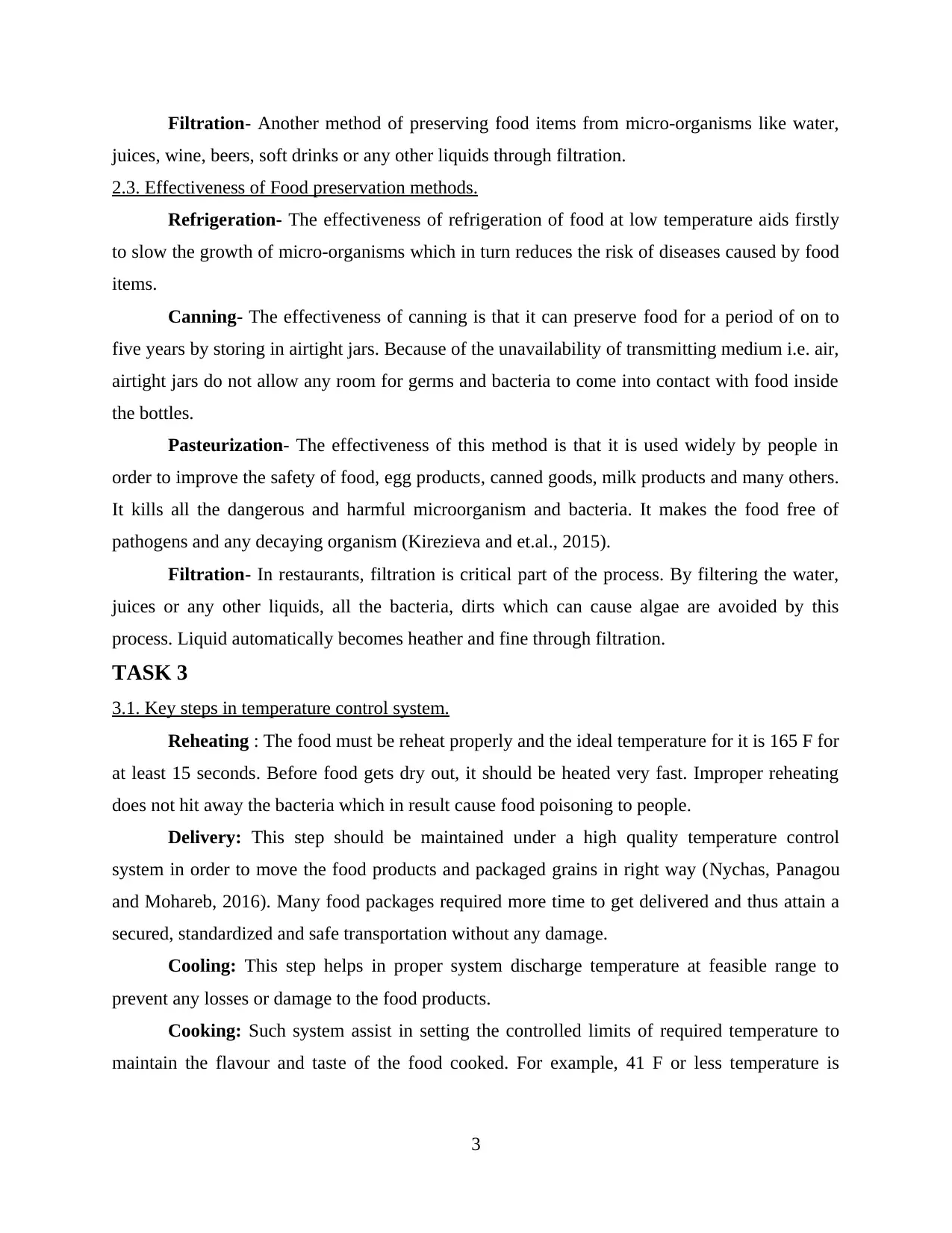
Filtration- Another method of preserving food items from micro-organisms like water,
juices, wine, beers, soft drinks or any other liquids through filtration.
2.3. Effectiveness of Food preservation methods.
Refrigeration- The effectiveness of refrigeration of food at low temperature aids firstly
to slow the growth of micro-organisms which in turn reduces the risk of diseases caused by food
items.
Canning- The effectiveness of canning is that it can preserve food for a period of on to
five years by storing in airtight jars. Because of the unavailability of transmitting medium i.e. air,
airtight jars do not allow any room for germs and bacteria to come into contact with food inside
the bottles.
Pasteurization- The effectiveness of this method is that it is used widely by people in
order to improve the safety of food, egg products, canned goods, milk products and many others.
It kills all the dangerous and harmful microorganism and bacteria. It makes the food free of
pathogens and any decaying organism (Kirezieva and et.al., 2015).
Filtration- In restaurants, filtration is critical part of the process. By filtering the water,
juices or any other liquids, all the bacteria, dirts which can cause algae are avoided by this
process. Liquid automatically becomes heather and fine through filtration.
TASK 3
3.1. Key steps in temperature control system.
Reheating : The food must be reheat properly and the ideal temperature for it is 165 F for
at least 15 seconds. Before food gets dry out, it should be heated very fast. Improper reheating
does not hit away the bacteria which in result cause food poisoning to people.
Delivery: This step should be maintained under a high quality temperature control
system in order to move the food products and packaged grains in right way (Nychas, Panagou
and Mohareb, 2016). Many food packages required more time to get delivered and thus attain a
secured, standardized and safe transportation without any damage.
Cooling: This step helps in proper system discharge temperature at feasible range to
prevent any losses or damage to the food products.
Cooking: Such system assist in setting the controlled limits of required temperature to
maintain the flavour and taste of the food cooked. For example, 41 F or less temperature is
3
juices, wine, beers, soft drinks or any other liquids through filtration.
2.3. Effectiveness of Food preservation methods.
Refrigeration- The effectiveness of refrigeration of food at low temperature aids firstly
to slow the growth of micro-organisms which in turn reduces the risk of diseases caused by food
items.
Canning- The effectiveness of canning is that it can preserve food for a period of on to
five years by storing in airtight jars. Because of the unavailability of transmitting medium i.e. air,
airtight jars do not allow any room for germs and bacteria to come into contact with food inside
the bottles.
Pasteurization- The effectiveness of this method is that it is used widely by people in
order to improve the safety of food, egg products, canned goods, milk products and many others.
It kills all the dangerous and harmful microorganism and bacteria. It makes the food free of
pathogens and any decaying organism (Kirezieva and et.al., 2015).
Filtration- In restaurants, filtration is critical part of the process. By filtering the water,
juices or any other liquids, all the bacteria, dirts which can cause algae are avoided by this
process. Liquid automatically becomes heather and fine through filtration.
TASK 3
3.1. Key steps in temperature control system.
Reheating : The food must be reheat properly and the ideal temperature for it is 165 F for
at least 15 seconds. Before food gets dry out, it should be heated very fast. Improper reheating
does not hit away the bacteria which in result cause food poisoning to people.
Delivery: This step should be maintained under a high quality temperature control
system in order to move the food products and packaged grains in right way (Nychas, Panagou
and Mohareb, 2016). Many food packages required more time to get delivered and thus attain a
secured, standardized and safe transportation without any damage.
Cooling: This step helps in proper system discharge temperature at feasible range to
prevent any losses or damage to the food products.
Cooking: Such system assist in setting the controlled limits of required temperature to
maintain the flavour and taste of the food cooked. For example, 41 F or less temperature is
3
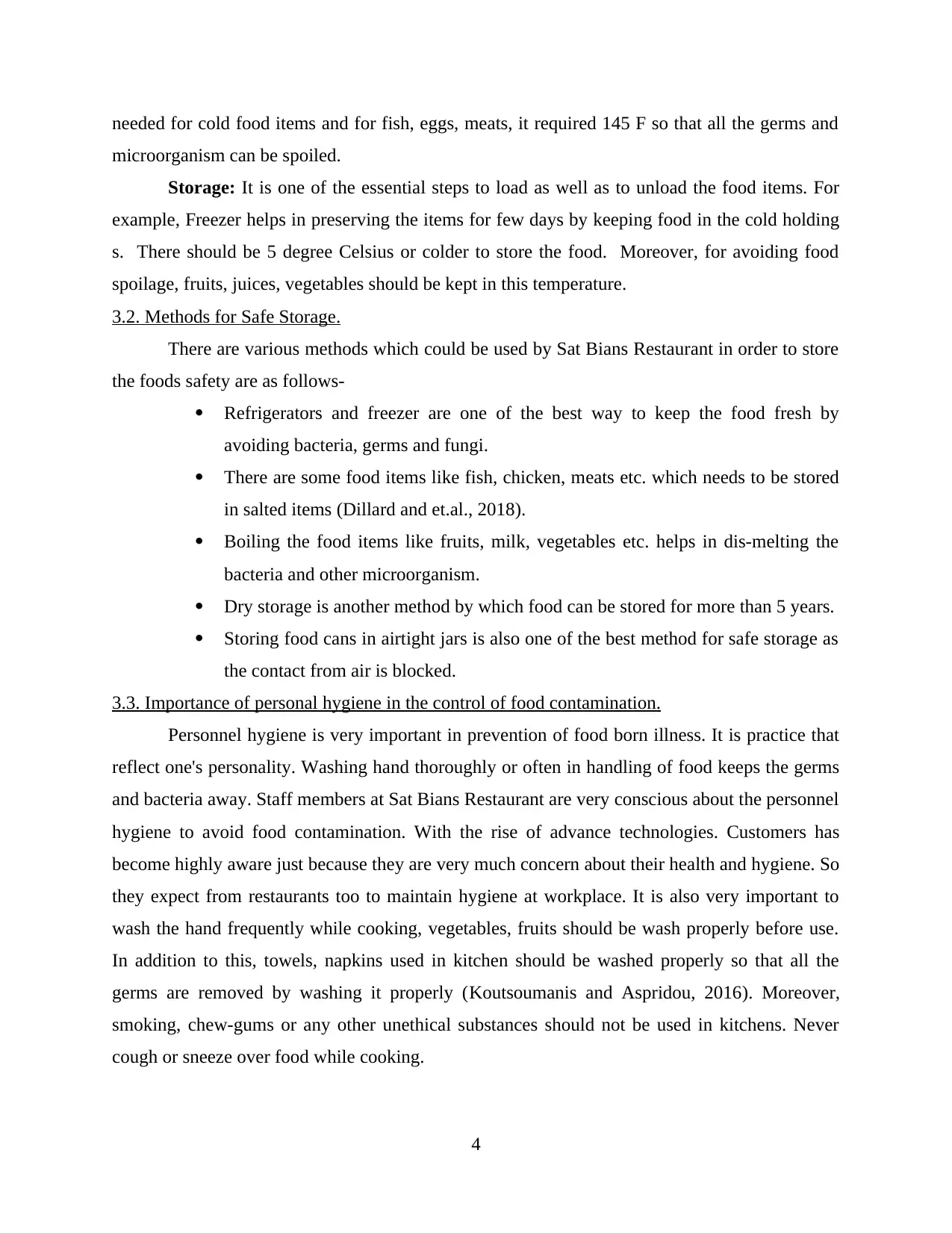
needed for cold food items and for fish, eggs, meats, it required 145 F so that all the germs and
microorganism can be spoiled.
Storage: It is one of the essential steps to load as well as to unload the food items. For
example, Freezer helps in preserving the items for few days by keeping food in the cold holding
s. There should be 5 degree Celsius or colder to store the food. Moreover, for avoiding food
spoilage, fruits, juices, vegetables should be kept in this temperature.
3.2. Methods for Safe Storage.
There are various methods which could be used by Sat Bians Restaurant in order to store
the foods safety are as follows-
Refrigerators and freezer are one of the best way to keep the food fresh by
avoiding bacteria, germs and fungi.
There are some food items like fish, chicken, meats etc. which needs to be stored
in salted items (Dillard and et.al., 2018).
Boiling the food items like fruits, milk, vegetables etc. helps in dis-melting the
bacteria and other microorganism.
Dry storage is another method by which food can be stored for more than 5 years.
Storing food cans in airtight jars is also one of the best method for safe storage as
the contact from air is blocked.
3.3. Importance of personal hygiene in the control of food contamination.
Personnel hygiene is very important in prevention of food born illness. It is practice that
reflect one's personality. Washing hand thoroughly or often in handling of food keeps the germs
and bacteria away. Staff members at Sat Bians Restaurant are very conscious about the personnel
hygiene to avoid food contamination. With the rise of advance technologies. Customers has
become highly aware just because they are very much concern about their health and hygiene. So
they expect from restaurants too to maintain hygiene at workplace. It is also very important to
wash the hand frequently while cooking, vegetables, fruits should be wash properly before use.
In addition to this, towels, napkins used in kitchen should be washed properly so that all the
germs are removed by washing it properly (Koutsoumanis and Aspridou, 2016). Moreover,
smoking, chew-gums or any other unethical substances should not be used in kitchens. Never
cough or sneeze over food while cooking.
4
microorganism can be spoiled.
Storage: It is one of the essential steps to load as well as to unload the food items. For
example, Freezer helps in preserving the items for few days by keeping food in the cold holding
s. There should be 5 degree Celsius or colder to store the food. Moreover, for avoiding food
spoilage, fruits, juices, vegetables should be kept in this temperature.
3.2. Methods for Safe Storage.
There are various methods which could be used by Sat Bians Restaurant in order to store
the foods safety are as follows-
Refrigerators and freezer are one of the best way to keep the food fresh by
avoiding bacteria, germs and fungi.
There are some food items like fish, chicken, meats etc. which needs to be stored
in salted items (Dillard and et.al., 2018).
Boiling the food items like fruits, milk, vegetables etc. helps in dis-melting the
bacteria and other microorganism.
Dry storage is another method by which food can be stored for more than 5 years.
Storing food cans in airtight jars is also one of the best method for safe storage as
the contact from air is blocked.
3.3. Importance of personal hygiene in the control of food contamination.
Personnel hygiene is very important in prevention of food born illness. It is practice that
reflect one's personality. Washing hand thoroughly or often in handling of food keeps the germs
and bacteria away. Staff members at Sat Bians Restaurant are very conscious about the personnel
hygiene to avoid food contamination. With the rise of advance technologies. Customers has
become highly aware just because they are very much concern about their health and hygiene. So
they expect from restaurants too to maintain hygiene at workplace. It is also very important to
wash the hand frequently while cooking, vegetables, fruits should be wash properly before use.
In addition to this, towels, napkins used in kitchen should be washed properly so that all the
germs are removed by washing it properly (Koutsoumanis and Aspridou, 2016). Moreover,
smoking, chew-gums or any other unethical substances should not be used in kitchens. Never
cough or sneeze over food while cooking.
4
⊘ This is a preview!⊘
Do you want full access?
Subscribe today to unlock all pages.

Trusted by 1+ million students worldwide
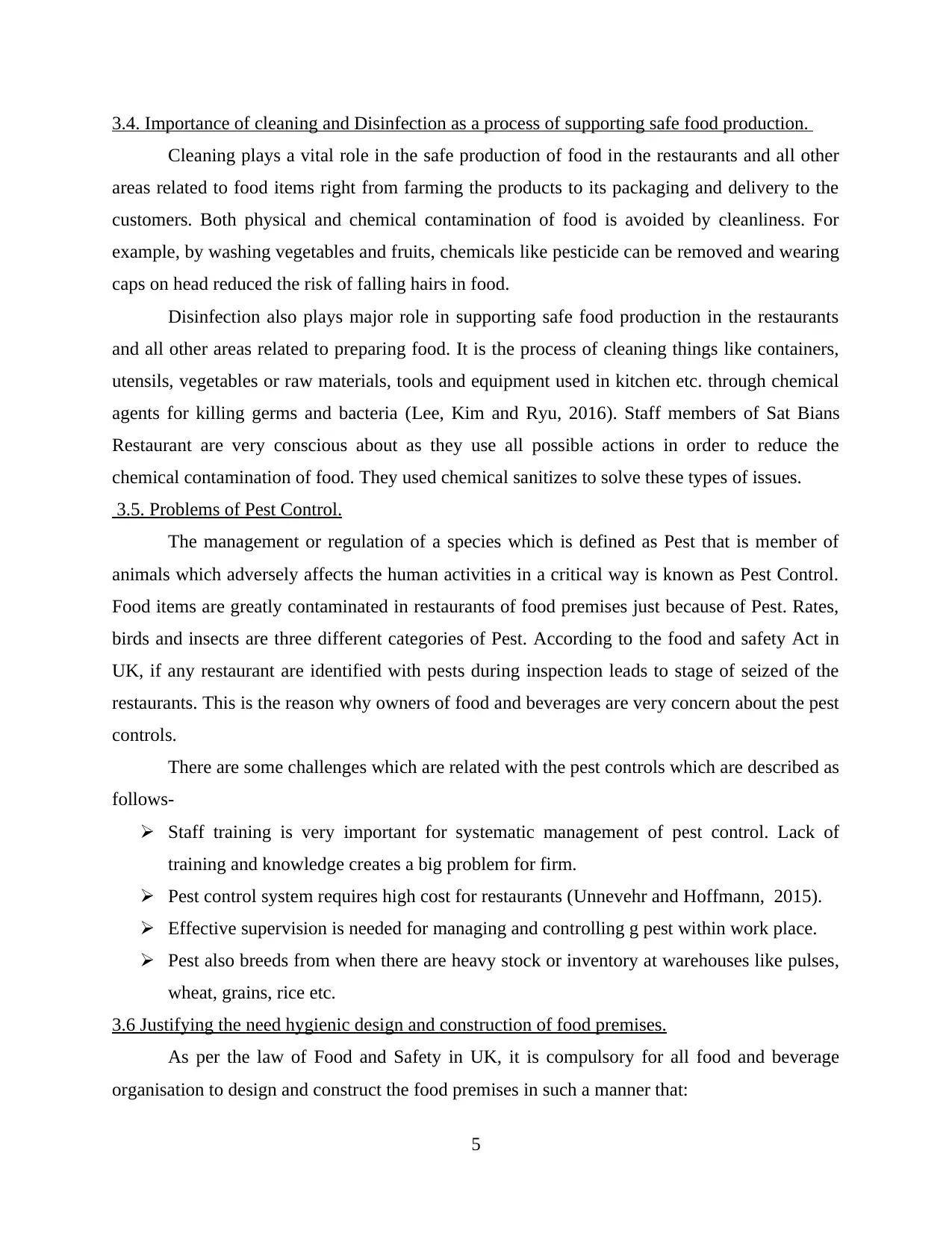
3.4. Importance of cleaning and Disinfection as a process of supporting safe food production.
Cleaning plays a vital role in the safe production of food in the restaurants and all other
areas related to food items right from farming the products to its packaging and delivery to the
customers. Both physical and chemical contamination of food is avoided by cleanliness. For
example, by washing vegetables and fruits, chemicals like pesticide can be removed and wearing
caps on head reduced the risk of falling hairs in food.
Disinfection also plays major role in supporting safe food production in the restaurants
and all other areas related to preparing food. It is the process of cleaning things like containers,
utensils, vegetables or raw materials, tools and equipment used in kitchen etc. through chemical
agents for killing germs and bacteria (Lee, Kim and Ryu, 2016). Staff members of Sat Bians
Restaurant are very conscious about as they use all possible actions in order to reduce the
chemical contamination of food. They used chemical sanitizes to solve these types of issues.
3.5. Problems of Pest Control.
The management or regulation of a species which is defined as Pest that is member of
animals which adversely affects the human activities in a critical way is known as Pest Control.
Food items are greatly contaminated in restaurants of food premises just because of Pest. Rates,
birds and insects are three different categories of Pest. According to the food and safety Act in
UK, if any restaurant are identified with pests during inspection leads to stage of seized of the
restaurants. This is the reason why owners of food and beverages are very concern about the pest
controls.
There are some challenges which are related with the pest controls which are described as
follows-
Staff training is very important for systematic management of pest control. Lack of
training and knowledge creates a big problem for firm.
Pest control system requires high cost for restaurants (Unnevehr and Hoffmann, 2015).
Effective supervision is needed for managing and controlling g pest within work place.
Pest also breeds from when there are heavy stock or inventory at warehouses like pulses,
wheat, grains, rice etc.
3.6 Justifying the need hygienic design and construction of food premises.
As per the law of Food and Safety in UK, it is compulsory for all food and beverage
organisation to design and construct the food premises in such a manner that:
5
Cleaning plays a vital role in the safe production of food in the restaurants and all other
areas related to food items right from farming the products to its packaging and delivery to the
customers. Both physical and chemical contamination of food is avoided by cleanliness. For
example, by washing vegetables and fruits, chemicals like pesticide can be removed and wearing
caps on head reduced the risk of falling hairs in food.
Disinfection also plays major role in supporting safe food production in the restaurants
and all other areas related to preparing food. It is the process of cleaning things like containers,
utensils, vegetables or raw materials, tools and equipment used in kitchen etc. through chemical
agents for killing germs and bacteria (Lee, Kim and Ryu, 2016). Staff members of Sat Bians
Restaurant are very conscious about as they use all possible actions in order to reduce the
chemical contamination of food. They used chemical sanitizes to solve these types of issues.
3.5. Problems of Pest Control.
The management or regulation of a species which is defined as Pest that is member of
animals which adversely affects the human activities in a critical way is known as Pest Control.
Food items are greatly contaminated in restaurants of food premises just because of Pest. Rates,
birds and insects are three different categories of Pest. According to the food and safety Act in
UK, if any restaurant are identified with pests during inspection leads to stage of seized of the
restaurants. This is the reason why owners of food and beverages are very concern about the pest
controls.
There are some challenges which are related with the pest controls which are described as
follows-
Staff training is very important for systematic management of pest control. Lack of
training and knowledge creates a big problem for firm.
Pest control system requires high cost for restaurants (Unnevehr and Hoffmann, 2015).
Effective supervision is needed for managing and controlling g pest within work place.
Pest also breeds from when there are heavy stock or inventory at warehouses like pulses,
wheat, grains, rice etc.
3.6 Justifying the need hygienic design and construction of food premises.
As per the law of Food and Safety in UK, it is compulsory for all food and beverage
organisation to design and construct the food premises in such a manner that:
5
Paraphrase This Document
Need a fresh take? Get an instant paraphrase of this document with our AI Paraphraser
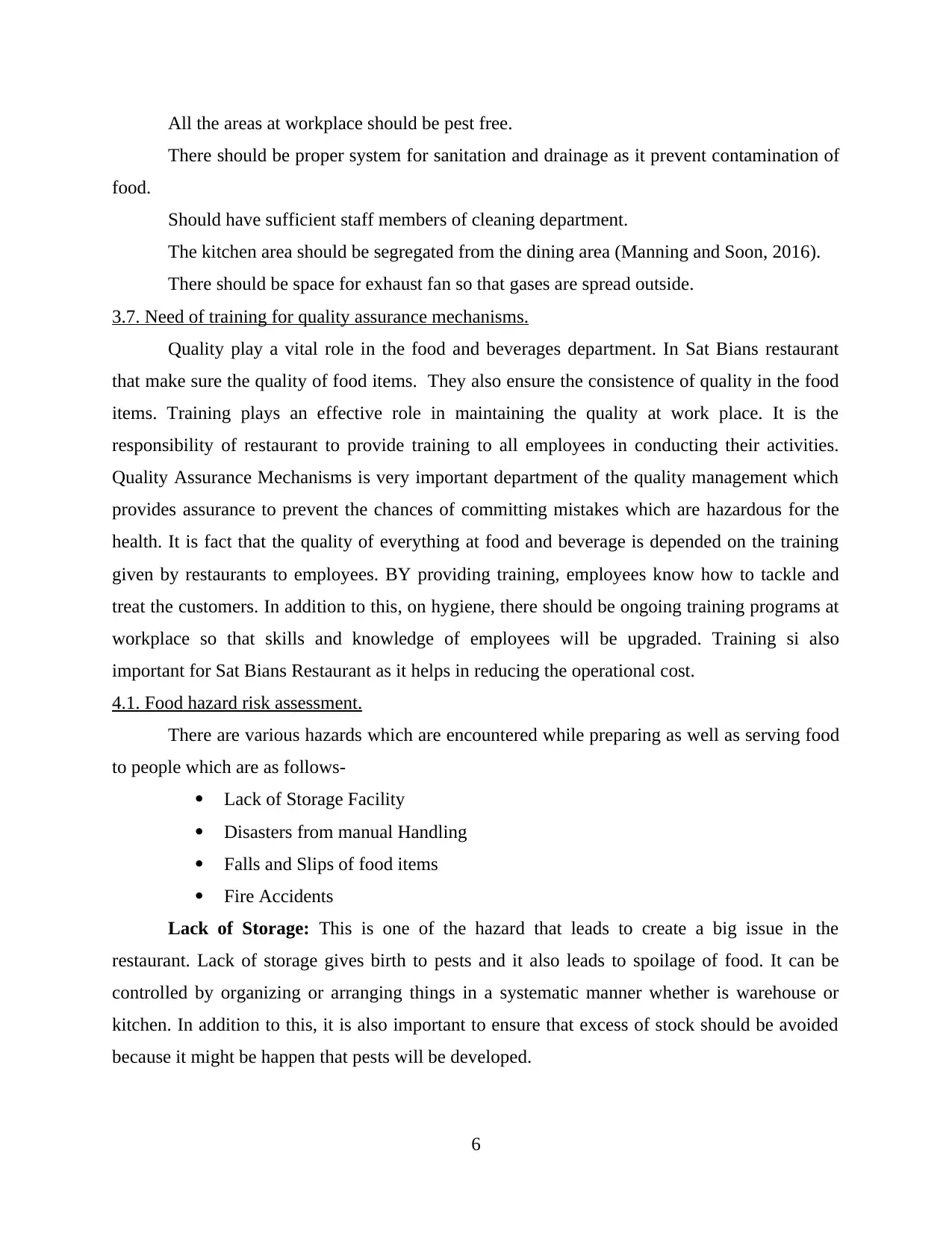
All the areas at workplace should be pest free.
There should be proper system for sanitation and drainage as it prevent contamination of
food.
Should have sufficient staff members of cleaning department.
The kitchen area should be segregated from the dining area (Manning and Soon, 2016).
There should be space for exhaust fan so that gases are spread outside.
3.7. Need of training for quality assurance mechanisms.
Quality play a vital role in the food and beverages department. In Sat Bians restaurant
that make sure the quality of food items. They also ensure the consistence of quality in the food
items. Training plays an effective role in maintaining the quality at work place. It is the
responsibility of restaurant to provide training to all employees in conducting their activities.
Quality Assurance Mechanisms is very important department of the quality management which
provides assurance to prevent the chances of committing mistakes which are hazardous for the
health. It is fact that the quality of everything at food and beverage is depended on the training
given by restaurants to employees. BY providing training, employees know how to tackle and
treat the customers. In addition to this, on hygiene, there should be ongoing training programs at
workplace so that skills and knowledge of employees will be upgraded. Training si also
important for Sat Bians Restaurant as it helps in reducing the operational cost.
4.1. Food hazard risk assessment.
There are various hazards which are encountered while preparing as well as serving food
to people which are as follows-
Lack of Storage Facility
Disasters from manual Handling
Falls and Slips of food items
Fire Accidents
Lack of Storage: This is one of the hazard that leads to create a big issue in the
restaurant. Lack of storage gives birth to pests and it also leads to spoilage of food. It can be
controlled by organizing or arranging things in a systematic manner whether is warehouse or
kitchen. In addition to this, it is also important to ensure that excess of stock should be avoided
because it might be happen that pests will be developed.
6
There should be proper system for sanitation and drainage as it prevent contamination of
food.
Should have sufficient staff members of cleaning department.
The kitchen area should be segregated from the dining area (Manning and Soon, 2016).
There should be space for exhaust fan so that gases are spread outside.
3.7. Need of training for quality assurance mechanisms.
Quality play a vital role in the food and beverages department. In Sat Bians restaurant
that make sure the quality of food items. They also ensure the consistence of quality in the food
items. Training plays an effective role in maintaining the quality at work place. It is the
responsibility of restaurant to provide training to all employees in conducting their activities.
Quality Assurance Mechanisms is very important department of the quality management which
provides assurance to prevent the chances of committing mistakes which are hazardous for the
health. It is fact that the quality of everything at food and beverage is depended on the training
given by restaurants to employees. BY providing training, employees know how to tackle and
treat the customers. In addition to this, on hygiene, there should be ongoing training programs at
workplace so that skills and knowledge of employees will be upgraded. Training si also
important for Sat Bians Restaurant as it helps in reducing the operational cost.
4.1. Food hazard risk assessment.
There are various hazards which are encountered while preparing as well as serving food
to people which are as follows-
Lack of Storage Facility
Disasters from manual Handling
Falls and Slips of food items
Fire Accidents
Lack of Storage: This is one of the hazard that leads to create a big issue in the
restaurant. Lack of storage gives birth to pests and it also leads to spoilage of food. It can be
controlled by organizing or arranging things in a systematic manner whether is warehouse or
kitchen. In addition to this, it is also important to ensure that excess of stock should be avoided
because it might be happen that pests will be developed.
6
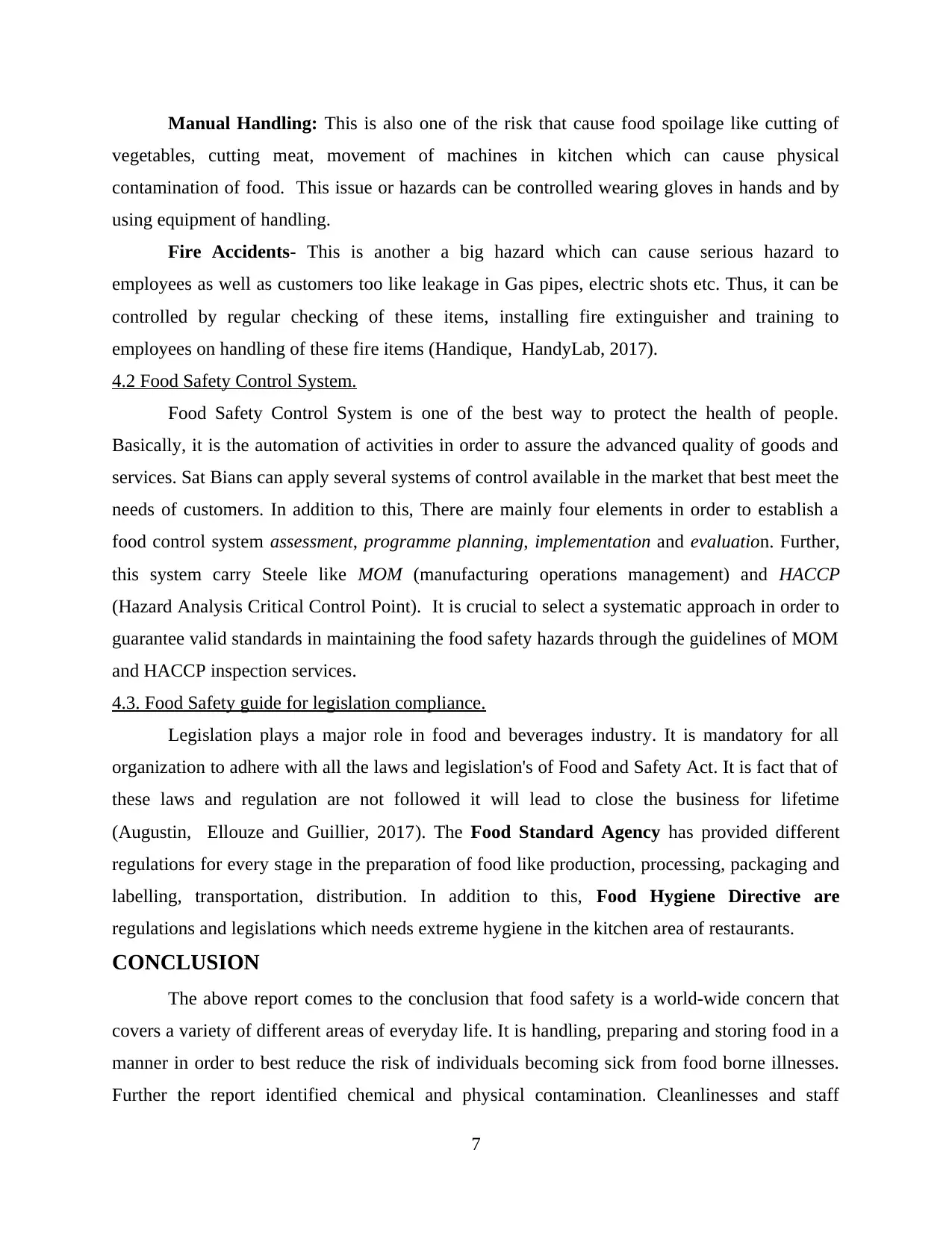
Manual Handling: This is also one of the risk that cause food spoilage like cutting of
vegetables, cutting meat, movement of machines in kitchen which can cause physical
contamination of food. This issue or hazards can be controlled wearing gloves in hands and by
using equipment of handling.
Fire Accidents- This is another a big hazard which can cause serious hazard to
employees as well as customers too like leakage in Gas pipes, electric shots etc. Thus, it can be
controlled by regular checking of these items, installing fire extinguisher and training to
employees on handling of these fire items (Handique, HandyLab, 2017).
4.2 Food Safety Control System.
Food Safety Control System is one of the best way to protect the health of people.
Basically, it is the automation of activities in order to assure the advanced quality of goods and
services. Sat Bians can apply several systems of control available in the market that best meet the
needs of customers. In addition to this, There are mainly four elements in order to establish a
food control system assessment, programme planning, implementation and evaluation. Further,
this system carry Steele like MOM (manufacturing operations management) and HACCP
(Hazard Analysis Critical Control Point). It is crucial to select a systematic approach in order to
guarantee valid standards in maintaining the food safety hazards through the guidelines of MOM
and HACCP inspection services.
4.3. Food Safety guide for legislation compliance.
Legislation plays a major role in food and beverages industry. It is mandatory for all
organization to adhere with all the laws and legislation's of Food and Safety Act. It is fact that of
these laws and regulation are not followed it will lead to close the business for lifetime
(Augustin, Ellouze and Guillier, 2017). The Food Standard Agency has provided different
regulations for every stage in the preparation of food like production, processing, packaging and
labelling, transportation, distribution. In addition to this, Food Hygiene Directive are
regulations and legislations which needs extreme hygiene in the kitchen area of restaurants.
CONCLUSION
The above report comes to the conclusion that food safety is a world-wide concern that
covers a variety of different areas of everyday life. It is handling, preparing and storing food in a
manner in order to best reduce the risk of individuals becoming sick from food borne illnesses.
Further the report identified chemical and physical contamination. Cleanlinesses and staff
7
vegetables, cutting meat, movement of machines in kitchen which can cause physical
contamination of food. This issue or hazards can be controlled wearing gloves in hands and by
using equipment of handling.
Fire Accidents- This is another a big hazard which can cause serious hazard to
employees as well as customers too like leakage in Gas pipes, electric shots etc. Thus, it can be
controlled by regular checking of these items, installing fire extinguisher and training to
employees on handling of these fire items (Handique, HandyLab, 2017).
4.2 Food Safety Control System.
Food Safety Control System is one of the best way to protect the health of people.
Basically, it is the automation of activities in order to assure the advanced quality of goods and
services. Sat Bians can apply several systems of control available in the market that best meet the
needs of customers. In addition to this, There are mainly four elements in order to establish a
food control system assessment, programme planning, implementation and evaluation. Further,
this system carry Steele like MOM (manufacturing operations management) and HACCP
(Hazard Analysis Critical Control Point). It is crucial to select a systematic approach in order to
guarantee valid standards in maintaining the food safety hazards through the guidelines of MOM
and HACCP inspection services.
4.3. Food Safety guide for legislation compliance.
Legislation plays a major role in food and beverages industry. It is mandatory for all
organization to adhere with all the laws and legislation's of Food and Safety Act. It is fact that of
these laws and regulation are not followed it will lead to close the business for lifetime
(Augustin, Ellouze and Guillier, 2017). The Food Standard Agency has provided different
regulations for every stage in the preparation of food like production, processing, packaging and
labelling, transportation, distribution. In addition to this, Food Hygiene Directive are
regulations and legislations which needs extreme hygiene in the kitchen area of restaurants.
CONCLUSION
The above report comes to the conclusion that food safety is a world-wide concern that
covers a variety of different areas of everyday life. It is handling, preparing and storing food in a
manner in order to best reduce the risk of individuals becoming sick from food borne illnesses.
Further the report identified chemical and physical contamination. Cleanlinesses and staff
7
⊘ This is a preview!⊘
Do you want full access?
Subscribe today to unlock all pages.

Trusted by 1+ million students worldwide
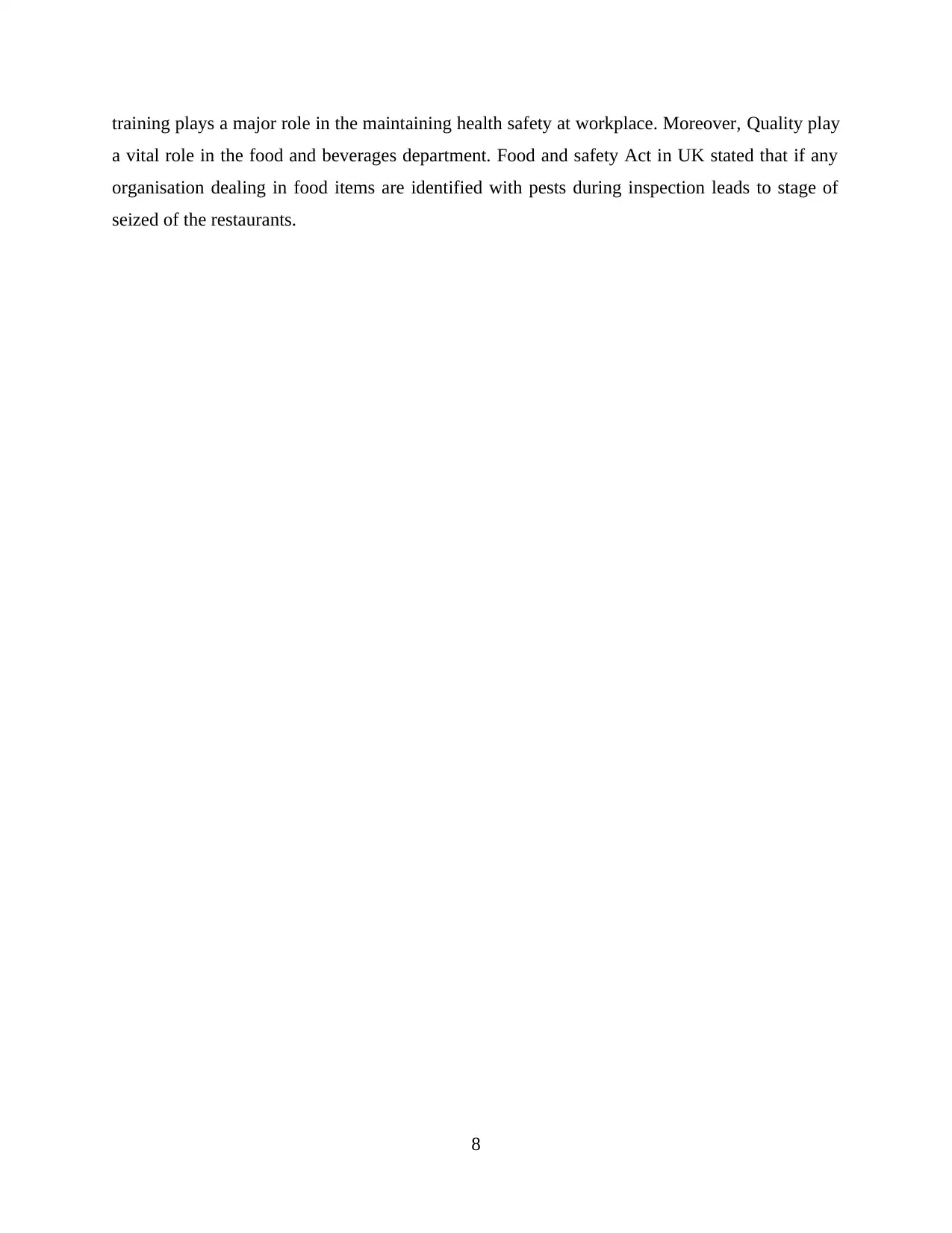
training plays a major role in the maintaining health safety at workplace. Moreover, Quality play
a vital role in the food and beverages department. Food and safety Act in UK stated that if any
organisation dealing in food items are identified with pests during inspection leads to stage of
seized of the restaurants.
8
a vital role in the food and beverages department. Food and safety Act in UK stated that if any
organisation dealing in food items are identified with pests during inspection leads to stage of
seized of the restaurants.
8
Paraphrase This Document
Need a fresh take? Get an instant paraphrase of this document with our AI Paraphraser
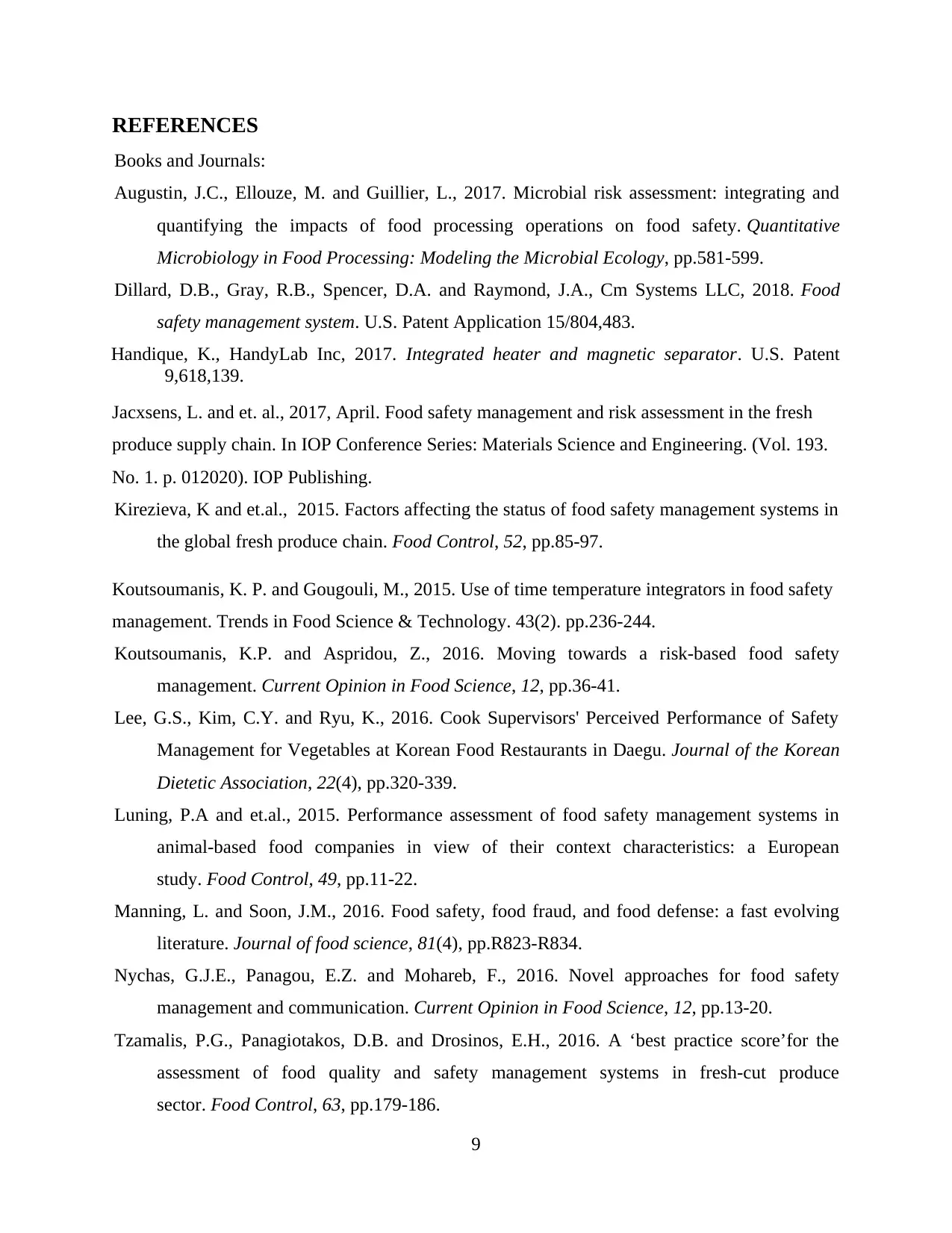
REFERENCES
Books and Journals:
Augustin, J.C., Ellouze, M. and Guillier, L., 2017. Microbial risk assessment: integrating and
quantifying the impacts of food processing operations on food safety. Quantitative
Microbiology in Food Processing: Modeling the Microbial Ecology, pp.581-599.
Dillard, D.B., Gray, R.B., Spencer, D.A. and Raymond, J.A., Cm Systems LLC, 2018. Food
safety management system. U.S. Patent Application 15/804,483.
Handique, K., HandyLab Inc, 2017. Integrated heater and magnetic separator. U.S. Patent
9,618,139.
Jacxsens, L. and et. al., 2017, April. Food safety management and risk assessment in the fresh
produce supply chain. In IOP Conference Series: Materials Science and Engineering. (Vol. 193.
No. 1. p. 012020). IOP Publishing.
Kirezieva, K and et.al., 2015. Factors affecting the status of food safety management systems in
the global fresh produce chain. Food Control, 52, pp.85-97.
Koutsoumanis, K. P. and Gougouli, M., 2015. Use of time temperature integrators in food safety
management. Trends in Food Science & Technology. 43(2). pp.236-244.
Koutsoumanis, K.P. and Aspridou, Z., 2016. Moving towards a risk-based food safety
management. Current Opinion in Food Science, 12, pp.36-41.
Lee, G.S., Kim, C.Y. and Ryu, K., 2016. Cook Supervisors' Perceived Performance of Safety
Management for Vegetables at Korean Food Restaurants in Daegu. Journal of the Korean
Dietetic Association, 22(4), pp.320-339.
Luning, P.A and et.al., 2015. Performance assessment of food safety management systems in
animal-based food companies in view of their context characteristics: a European
study. Food Control, 49, pp.11-22.
Manning, L. and Soon, J.M., 2016. Food safety, food fraud, and food defense: a fast evolving
literature. Journal of food science, 81(4), pp.R823-R834.
Nychas, G.J.E., Panagou, E.Z. and Mohareb, F., 2016. Novel approaches for food safety
management and communication. Current Opinion in Food Science, 12, pp.13-20.
Tzamalis, P.G., Panagiotakos, D.B. and Drosinos, E.H., 2016. A ‘best practice score’for the
assessment of food quality and safety management systems in fresh-cut produce
sector. Food Control, 63, pp.179-186.
9
Books and Journals:
Augustin, J.C., Ellouze, M. and Guillier, L., 2017. Microbial risk assessment: integrating and
quantifying the impacts of food processing operations on food safety. Quantitative
Microbiology in Food Processing: Modeling the Microbial Ecology, pp.581-599.
Dillard, D.B., Gray, R.B., Spencer, D.A. and Raymond, J.A., Cm Systems LLC, 2018. Food
safety management system. U.S. Patent Application 15/804,483.
Handique, K., HandyLab Inc, 2017. Integrated heater and magnetic separator. U.S. Patent
9,618,139.
Jacxsens, L. and et. al., 2017, April. Food safety management and risk assessment in the fresh
produce supply chain. In IOP Conference Series: Materials Science and Engineering. (Vol. 193.
No. 1. p. 012020). IOP Publishing.
Kirezieva, K and et.al., 2015. Factors affecting the status of food safety management systems in
the global fresh produce chain. Food Control, 52, pp.85-97.
Koutsoumanis, K. P. and Gougouli, M., 2015. Use of time temperature integrators in food safety
management. Trends in Food Science & Technology. 43(2). pp.236-244.
Koutsoumanis, K.P. and Aspridou, Z., 2016. Moving towards a risk-based food safety
management. Current Opinion in Food Science, 12, pp.36-41.
Lee, G.S., Kim, C.Y. and Ryu, K., 2016. Cook Supervisors' Perceived Performance of Safety
Management for Vegetables at Korean Food Restaurants in Daegu. Journal of the Korean
Dietetic Association, 22(4), pp.320-339.
Luning, P.A and et.al., 2015. Performance assessment of food safety management systems in
animal-based food companies in view of their context characteristics: a European
study. Food Control, 49, pp.11-22.
Manning, L. and Soon, J.M., 2016. Food safety, food fraud, and food defense: a fast evolving
literature. Journal of food science, 81(4), pp.R823-R834.
Nychas, G.J.E., Panagou, E.Z. and Mohareb, F., 2016. Novel approaches for food safety
management and communication. Current Opinion in Food Science, 12, pp.13-20.
Tzamalis, P.G., Panagiotakos, D.B. and Drosinos, E.H., 2016. A ‘best practice score’for the
assessment of food quality and safety management systems in fresh-cut produce
sector. Food Control, 63, pp.179-186.
9
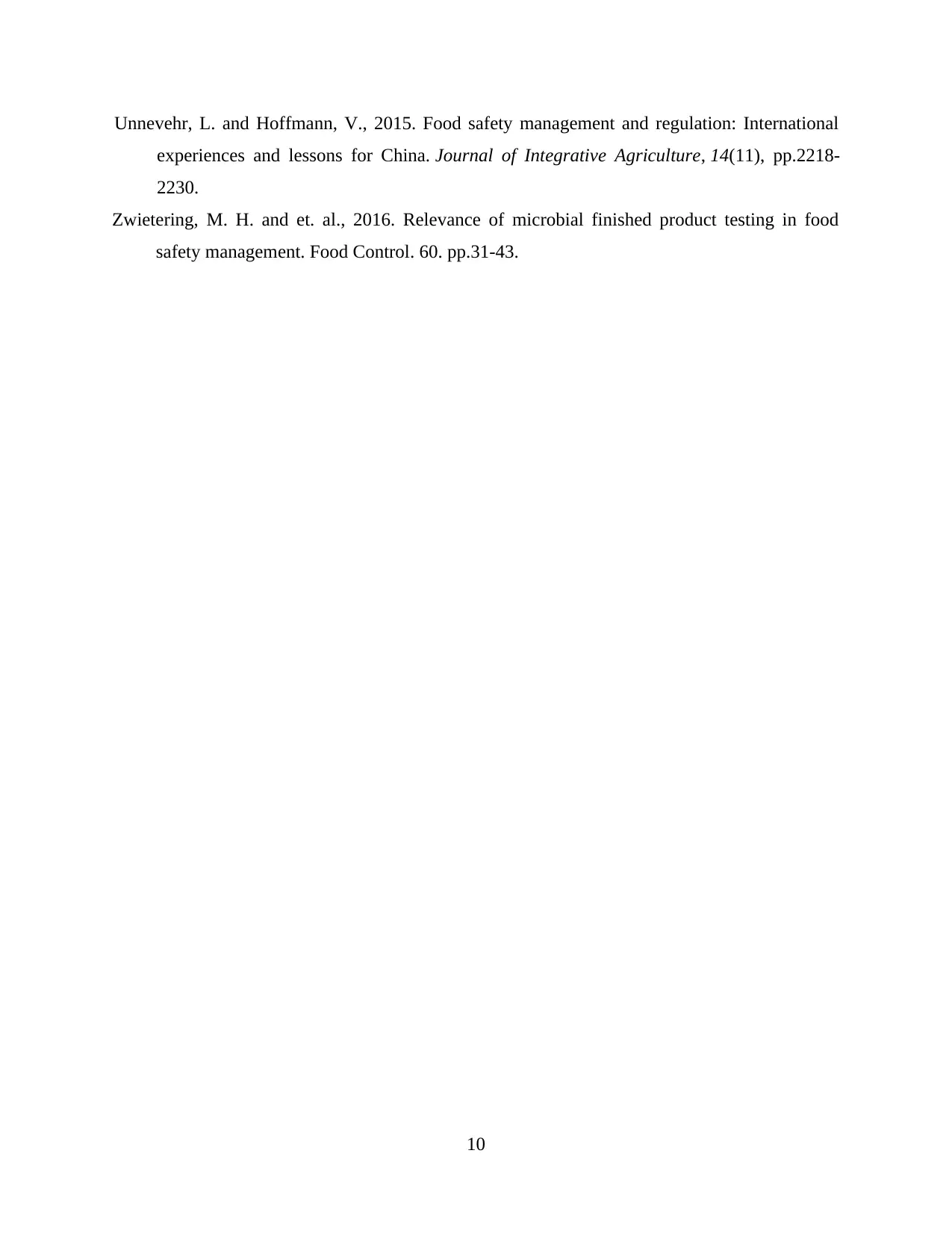
Unnevehr, L. and Hoffmann, V., 2015. Food safety management and regulation: International
experiences and lessons for China. Journal of Integrative Agriculture, 14(11), pp.2218-
2230.
Zwietering, M. H. and et. al., 2016. Relevance of microbial finished product testing in food
safety management. Food Control. 60. pp.31-43.
10
experiences and lessons for China. Journal of Integrative Agriculture, 14(11), pp.2218-
2230.
Zwietering, M. H. and et. al., 2016. Relevance of microbial finished product testing in food
safety management. Food Control. 60. pp.31-43.
10
⊘ This is a preview!⊘
Do you want full access?
Subscribe today to unlock all pages.

Trusted by 1+ million students worldwide
1 out of 13
Related Documents
Your All-in-One AI-Powered Toolkit for Academic Success.
+13062052269
info@desklib.com
Available 24*7 on WhatsApp / Email
![[object Object]](/_next/static/media/star-bottom.7253800d.svg)
Unlock your academic potential
Copyright © 2020–2025 A2Z Services. All Rights Reserved. Developed and managed by ZUCOL.





